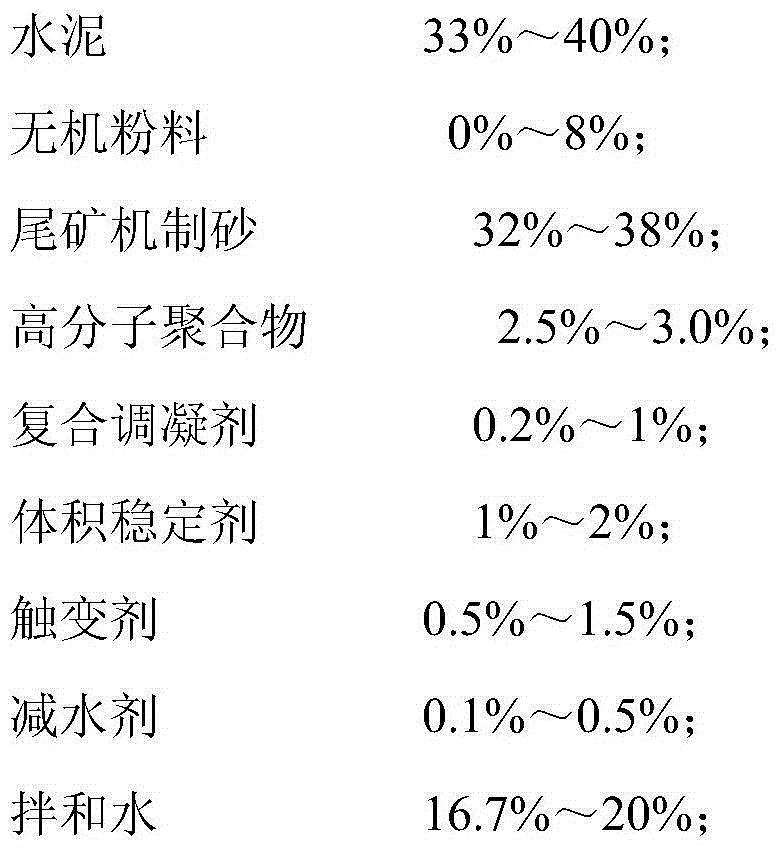Cement-based composite material for 3D printing technology and its preparation method and use
A 3D printing and composite material technology, which is applied in the field of cement-based composite materials and its preparation, can solve the problems of poor mechanical properties, long setting time, and high requirements for printing conditions
- Summary
- Abstract
- Description
- Claims
- Application Information
AI Technical Summary
Problems solved by technology
Method used
Image
Examples
Embodiment 1
[0060] 30% sulfoaluminate cement, 3% ordinary portland cement, 8% mineral powder, 38% tailings machine-made sand, 2.7% polymer, 0.2% naphthalene-based high-efficiency water reducer, 0.05% lithium carbonate, Sodium tetraborate 0.1%, sodium gluconate 0.1%, tartaric acid 0.05%, thixotropic agent 0.5%, starch ether 0.2%, polypropylene fiber 0.1%, shrinkage reducing agent 1%, mixing water 16.2%.
[0061] The preparation method of the above-mentioned 3D printing materials is as follows: pre-mix the above powdery raw materials, add water and fully stir them, and then pump them and extrude them for construction by a construction 3D printer. The amount of stirring each time can be controlled according to the printing speed. The specific steps are as follows: Step 1. Preparation of retarder: Weigh or measure sodium tetraborate, sodium gluconate and tartaric acid in proportion, mix them uniformly, and prepare retarder for use;
[0062] Step 2, preparing a composite coagulation regulator:...
Embodiment 2
[0070] Sulphoaluminate cement 40%, fly ash 5%, tailings machine-made sand 32%, polymer 3%, naphthalene superplasticizer 0.25%, lithium carbonate 0.1%, sodium tetraborate 0.1%, glucose Sodium saccharate 0.1%, tartaric acid 0.05%, thixotropic agent 1%, starch ether 0.1%, polypropylene fiber 0.1%, shrinkage reducing agent 1.2%, mixing water 17%.
[0071] The specific implementation steps are the same as those in Embodiment 1, and the amount of stirring each time can be controlled according to the printing speed.
[0072] The performance of the cement-based composite material printed by 3D in this embodiment is tested, and the test results are as follows:
[0073] The initial setting time is 25min, the end time is 37min,
[0074] Compressive strength R 2h =18.3MPa, R3d=43.1MPa, R 28d =57.2MPa
[0075] Free expansion rate: 0.010%.
Embodiment 3
[0077] Sulphoaluminate cement 30%, ordinary Portland cement 5%, S95 grade mineral powder 8%, tailings machine-made sand 35%, high molecular polymer 2.5%, naphthalene-based superplasticizer 0.2%, lithium carbonate 0.05% , sodium tetraborate 0.1%, sodium gluconate 0.1%, thixotropic agent 0.5%, polypropylene fiber 0.1%, starch ether 0.25%, shrinkage reducing agent 1%, mixing water 17.2%.
[0078] The specific implementation steps are the same as those in Embodiment 1, and the amount of stirring each time can be controlled according to the printing speed.
[0079] The performance of the cement-based composite material printed by 3D in this embodiment is tested, and the test results are as follows:
[0080] The initial setting time is 35 minutes, and the final time is 48 minutes;
[0081] Compressive strength R 2h =16.5MPa, R3d=43.2MPa, R 28d =53.6MPa;
[0082] Free expansion rate: 0.013%.
PUM
| Property | Measurement | Unit |
|---|---|---|
| compressive strength | aaaaa | aaaaa |
| compressive strength | aaaaa | aaaaa |
| compressive strength | aaaaa | aaaaa |
Abstract
Description
Claims
Application Information
 Login to View More
Login to View More - R&D
- Intellectual Property
- Life Sciences
- Materials
- Tech Scout
- Unparalleled Data Quality
- Higher Quality Content
- 60% Fewer Hallucinations
Browse by: Latest US Patents, China's latest patents, Technical Efficacy Thesaurus, Application Domain, Technology Topic, Popular Technical Reports.
© 2025 PatSnap. All rights reserved.Legal|Privacy policy|Modern Slavery Act Transparency Statement|Sitemap|About US| Contact US: help@patsnap.com

